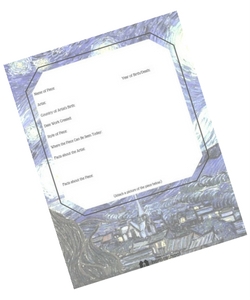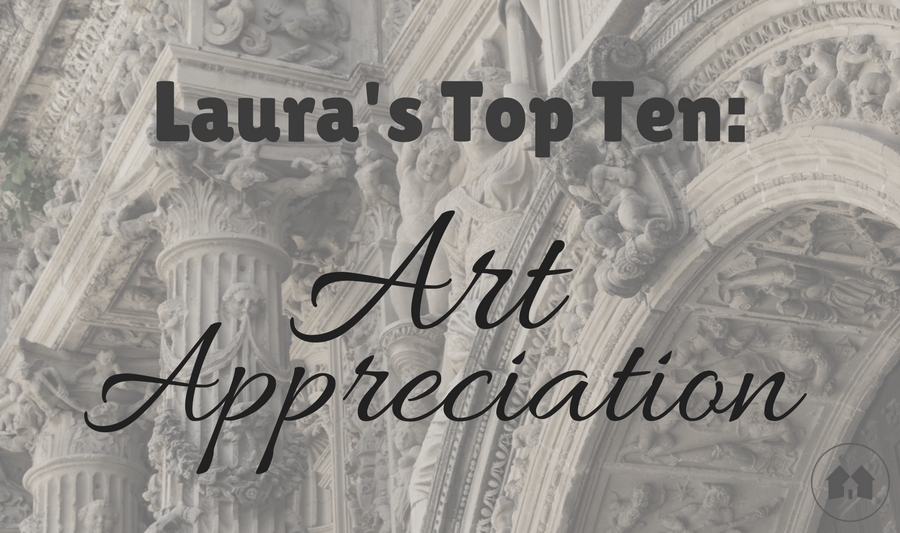Introducing: Laura’s Top Ten
In the course of homeschooling for 20 years, you learn a lot. You accumulate a long list of what worked and what didn’t, what should have been discarded, and where we should have camped out awhile. Isn’t that the nature of life? We always learn by doing; home education is no exception. It’s on-the-job training. We do the best with what we know, and give ourselves grace for what we didn’t know.
Letting go of regret, we thank God for His provision and forge on ahead.
Even though we can’t live it all again with the benefit of 20/20 hindsight, we can share what we’ve learned with the homeschooling sisters coming along behind us. That’s you, my friend! I’m not claiming to be an expert, but I learned a thing or two in our home school journey. My new series, Laura’s Top Ten, is an opportunity to pass along some of what really worked for our family. Please use what you can, tweak or adapt to your own situation, and just discard the rest.
Home education is like a tailored suit; we can reject the one-size-fits-all methods that are inherently built in to every public, private, and parochial school classroom. The sheer number of students in those places makes it impossible to do things any other way, but our choice to home educate gives us nearly infinite options. We can shorten, add length, change the format, and do whatever we want. In your homeschool, you are the designer! Use your creative powers well!
Home education is like a tailored suit; we can reject the one-size-fits-all methods that are inherently built in to every public, private, and parochial school classroom. Click To TweetLaura’s Top Ten is designed to equip you with lots of practical ideas for planning and managing your homeschool. The series will go beyond the 3Rs. Because homeschool combines both home and school (not to be TOO obvious!), topics will run the gamut including home and hearth management, enrichment learning, and other fun topics. Look for future posts on life skills, clutter control, money saving tips, vacation ideas, learning geography, books you must not overlook, and scriptures that must (in my opinion) be memorized—but you get to choose!
Laura’s Top Ten: Art Appreciation
Art was never my strong suit and, as a business major, I mentally rolled my eyes at those general education college requirements intended to make me a well-rounded person. That changed the summer I enrolled in an Art Appreciation course at my local community college. (Trying to finish a double-major undergraduate degree in three years made summer classes a necessity!)
I signed up for the credits. But I fell in love with fine art.
As the professor introduced us to styles, famous pieces, and the artists who created them, I began to feel…cultured. Enlightened. Even a little highbrow. The little girl born a coal miner’s daughter from West Virginia began to get a sense that “well educated” might mean more than graduating with honors and a lucrative job at the end of my college career.
History had always appealed to me, but I began to see art not only as a means to capture the past in pictures, but also to depict beauty, display feelings, and communicate beyond words. That summer class opened my eyes and my heart. Looking back, I also realize it dealt with some pride, as well—by teaching me to embrace all subjects as valuable, capable of broadening my mind, perspective and understanding.
To this day, I love art museums. Docent-led tours are a particular favorite, because the work has already been done for me by people with inside knowledge: they’ve gleaned the most fascinating facts about both the artist and the piece, and they love art enough to volunteer (usually) in the museum. Their passion is contagious, and I always leave knowing more than when I arrived.
There’s also something so very satisfying about encountering a work I already know. As I approached Georges Seurat’s A Sunday On La Grande Jatte at the Art Institute of Chicago, I found myself trembling and thinking, “I know this painting!” I’m not sure I ever felt more educated. Though I knew what pointillism was (again, thanks to that summer class!), seeing it in person was a game-changer. I was also astounded by the sheer size of the piece—much, much larger than I had envisioned. Other times, I’ve been surprised by how small a piece is in person.
Through the years, we visited many art museums while on vacation, collecting postcards from the gift shops to add to our family collection. They made great flash cards to quiz our now-adult kids. Confirmation that this part of our homeschool made an impact came when I got a text from my oldest daughter, showing a wall-sized canvas of Monet’s Woman With A Parasol she had ordered online to display in her apartment. Her text read, “Thanks, Mom, for instilling in me an appreciation for beautiful art.” A mama can go a long way on words like those!
Rather than waiting for Art Appreciation 101, I suggest you begin exposing your child to masterpieces in elementary school. Go easy. Don’t try to overwhelm them (or you) with one each week—just aim for one new piece per month. If you have a ten-month school year and begin in first grade, you will have added 120 pieces to their art repertoire by high school graduation!
Below are ten of my favorites to get you started. You will also find links to view the pieces online and some recommended books, biographies, and other resources.
 Finally, we’re offering a free
Art Appreciation Notebooking Page
for download. You can print a copy for each piece, ask your child to complete it, and build an Art Appreciation notebook that allows him to keep cycling back to review and remember. You can even build it into a high school credit by assigning a research paper on the artist and/or an observation piece on the work. The possibilities are endless!
Finally, we’re offering a free
Art Appreciation Notebooking Page
for download. You can print a copy for each piece, ask your child to complete it, and build an Art Appreciation notebook that allows him to keep cycling back to review and remember. You can even build it into a high school credit by assigning a research paper on the artist and/or an observation piece on the work. The possibilities are endless!
It was a challenge to choose just ten, but here’s my initial list. Happy appreciating!
|
Artist |
Name of Piece |
See it Here |
Additional Resource |
|
Claude Monet |
Water Lily Pond (series) |
The Met Fifth Avenue (New York) or online here |
|
|
Georges Seurat |
A Sunday on La Grande Jatte |
The Art Institute (Chicago) or online here |
Sunday with Seurat by Julie Merberg & Suzanne Bober |
|
Vincent van Gogh |
Starry Night |
The Museum of Modern Art (NY) or online here |
Vincent van Gogh: The Starry Night by Richard Thomson |
|
Leonardo da Vinci |
The Last Supper |
Convent of Santa Maria delle Grazie, Milan, Italy, or online here |
Leonardo da Vinci for Kids: His Life and Ideas, 21 Activities by Janis Herbert |
|
Grant Wood |
American Gothic |
The Art Institute (Chicago) or online here |
American Gothic: The Life of Grant Wood by Susan Wood |
|
Mary Cassatt |
The Boating Party |
National Gallery of Art, Washington, D.C., or online here |
Mary Cassatt (Getting to Know The World’s Greatest Artists) by Mike Venezia |
|
Pablo Picasso |
The Three Musicians |
The Museum of Modern Art (NY) or online here |
Pablo Picasso (Getting to Know The World’s Greatest Artists) by Mike Venezia |
|
Michelangelo |
Sistine Chapel Ceiling |
Sistine Chapel, Vatican City |
|
|
Norman Rockwell |
Rosie the Riveter |
Crystal Bridges Museum of American Art, Bentonville, AR or online here |
Rosie the Riveter: Women Working on the Home Front in WWII by Penny Colman |
|
Auguste Renoir |
A Girl With A Watering Can |
National Gallery of Art, Washington, D.C., or online here |
Pierre Auguste Renoir (Getting to Know The World’s Greatest Artists) by Mike Venezia |

What a great reminder especially since art is not my strength. Thankful our coop introduces art pieces but I really need to take my kiddos to the museum downtown since we have never been oops.
It’s such a fun and easy add-in to our curriculum. Let’s us know how it goes, Lindsey!